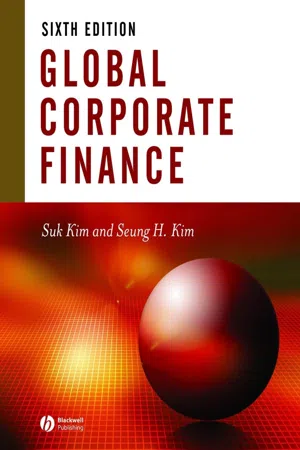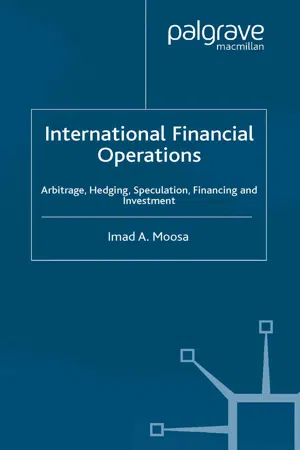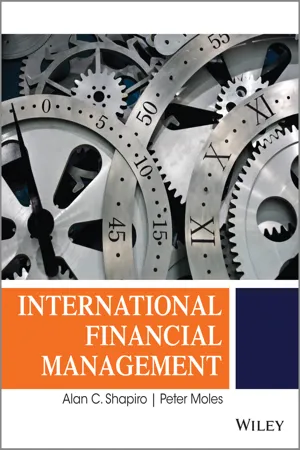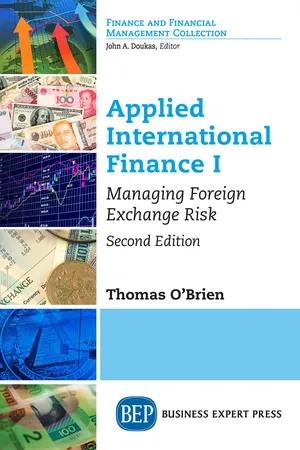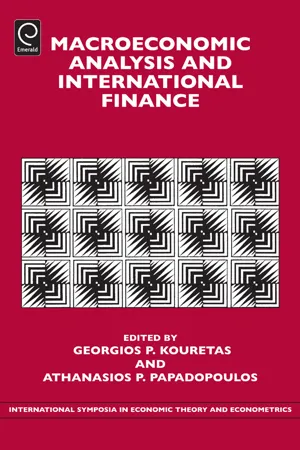Business
Economic Exposure
Economic exposure refers to the risk a company faces from fluctuations in exchange rates, which can impact its future cash flows, profits, and competitive position. It reflects the potential impact of currency movements on a company's international operations and financial performance. Managing economic exposure involves strategies such as hedging and diversification to mitigate the potential adverse effects of currency fluctuations.
Written by Perlego with AI-assistance
Related key terms
1 of 5
10 Key excerpts on "Economic Exposure"
- eBook - PDF
Exchange Rates and the Firm
Strategies to Manage Exposure and the Impact of EMU
- R. Friberg(Author)
- 1999(Publication Date)
- Palgrave Macmillan(Publisher)
Part II Economic Exposure 6 Economic Exposure Economic Exposure is defined as the sensitivity in the value of the firm to exchange rate surprises. For this purpose the firm’s value is meas- ured as the present discounted value of expected future cash flows. Since Economic Exposure is concerned with cash flows and the value of the firm, the reasons for hedging that we mentioned in Chapter 4 are potentially important. The most common distinction is to say that Economic Exposure con- sists of, on the one hand, contractual (transaction) exposure and, on the other hand, operating exposure. As suggested by the name, con- tractual exposure refers to already known net flows in foreign cur- rency – past contractual undertakings that have future cash flow consequences. The extent of the operating exposure (and hence econ- omic exposure) hinges on how the firm, consumers, and competitors respond to exchange rate changes. How do the prices of your com- petitor change, how do you change your prices, how sensitive is demand to price changes, to what extent can you set prices on differ- ent national markets independently? These are all questions relating to Economic Exposure. It is thus clear that economic and operating exposure are ruled by issues relating to industrial organization and macroeconomics as well as to financial issues. In the rest of Part II we will show how one can measure Economic Exposure using econometric techniques, and learn about the mecha- nisms relating the value of a firm and its cash flows to the value of currencies. Before we do that, however, let us spend some time further clarifying concepts. One important issue to understand is that a firm may be exposed to exchange rate changes even if it has no foreign subsidiaries (no accounting exposure) or has no cash flows denominated in foreign currency (no contractual exposure). - eBook - PDF
Global Corporate Finance
Text and Cases
- Suk H. Kim, Seung H. Kim(Authors)
- 2009(Publication Date)
- Wiley-Blackwell(Publisher)
It also buys currency options to hedge certain anticipated sales. Source : J. D. Daniels, L. H. Radebaugh, and D. P. Sullivan, International Business: Environments and Operations , 10th edn, Upper Saddle River, NJ: Prentice Hall, 2004, p. 620. 9.1.2 Transaction exposure Gains or losses may result from the settlement of transactions whose payment terms are stated in a foreign currency. Transaction exposure refers to the potential change in the value of out-standing obligations due to changes in the exchange rate between the inception of a contract and the settlement of the contract. Transactions that are subject to transaction exposure include credit purchases and credit sales whose prices are stated in foreign currencies, borrowed and loaned funds denominated in foreign currencies, and uncovered forward contracts. Receipts and payments denominated in foreign currencies are considered to be exposed. If exposed receipts are greater than exposed payments, foreign-currency depreciations will cause exchange losses, and foreign-currency appreciations will cause exchange gains. On the other hand, if exposed receipts are smaller than exposed payments, foreign-currency depreciations will create exchange gains, and foreign-currency appreciations will create exchange losses. 9.1.3 Economic Exposure Economic Exposure , also called operating exposure, competitive exposure, or revenue exposure, measures the impact of an exchange rate change on the net present value of expected future cash flows from a foreign investment project. Future effects of changes in exchange rates occur under the general category of economic risk. An MNC may have established its subsidiary in a country with price stability, readily available funds, a favorable balance of payments, and low rates of tax-ation. These positive features may disappear over time if the economic situation of the country deteriorates. Eventually, the local currency will devalue or depreciate. - eBook - PDF
International Financial Operations
Arbitrage, Hedging, Speculation, Financing and Investment
- I. Moosa(Author)
- 2003(Publication Date)
- Palgrave Macmillan(Publisher)
This may sound like transaction exposure, but the difference lies in the fact that we are in this case concerned with non- contractual or unplanned future cash flows. These cash flows pertain to sales in foreign and domestic markets, as well as input costs, whether these inputs are domestic or foreign. While transaction exposure arises from transactions that are planned, currently in progress or have already been completed, Economic Exposure refers to changes in future earning power as a result of changes in exchange rates. Economic Exposure arises because of the effect of changes in exchange rates on a firm’s cash flows (revenues and costs) and its equity value. If the refer- ence is to the firm’s operating cash flows, then the exposure is called operating exposure. If, on the other hand, we are concerned with the firm’s equity value, then it is equity exposure. We will deal with equity exposure in a subsequent chapter, but in this section we concentrate on operating exposure. Economic Exposure is sometimes portrayed as consisting of transaction exposure and operating exposure. Operating exposure can be defined as the extent to which the firm’s operating cash flows would be affected by random changes in exchange rates. Lessard and Lightstone (1986) argue that business executives are more familiar with transaction exposure than with operating exposure. They also argue that operating exposure has become increasingly important because exchange rates have become more volatile and business has become more international. There are key questions to ask when considering Economic Exposure. These questions pertain to where the firm produces, where it sells its products, and where it sources its output. They also pertain to whether competition is domestic or foreign and to the currency of pricing. Table 4.4 presents these questions and their implications. Generally speaking, foreign components are associated with higher exposure. - eBook - PDF
- Alan C. Shapiro, Paul Hanouna(Authors)
- 2019(Publication Date)
- Wiley(Publisher)
Fluctuations in exchange rates will continue to have “real” effects on the cash profitability of foreign subsidiaries— complicating overseas selling, pricing, buying, and plant-location decisions. 287 288 MEASURING AND MANAGING Economic Exposure This chapter develops an appropriate definition of foreign exchange risk. It discusses the economic, as distinguished from the accounting, consequences of currency changes on a firm’s value and shows how Economic Exposure can be measured. This chapter also discusses the marketing, production, and finan- cial management strategies that are appropriate for coping with the economic consequences of exchange rate changes. 10.1 FOREIGN EXCHANGE RISK AND Economic Exposure The most important aspect of foreign exchange risk management is to incorporate currency change expecta- tions into all basic corporate decisions. In performing this task, the firm must know what is at risk. However, there is a major discrepancy between accounting practice and economic reality in terms of measuring expo- sure, which is the degree to which a company is affected by exchange rate changes. As we saw in Chapter 9, those who use an accounting definition of exposure—whether FASB 52 or some other method—divide the balance sheet’s assets and liabilities into those accounts that will be affected by exchange rate changes and those that will not. In contrast, economic theory focuses on the impact of an exchange rate change on future cash flows. That is, Economic Exposure is based on the extent to which the value of the firm—as measured by the present value (PV) of its expected future cash flows—will change when exchange rates change. Specifically, if PV is the present value of a firm, then that firm is exposed to currency risk if ΔPV/Δe is not equal to zero, where ΔPV is the change in the firm’s present value associated with an exchange rate change, Δe. - eBook - PDF
- Alan C. Shapiro, Peter Moles(Authors)
- 2014(Publication Date)
- Wiley(Publisher)
11.2 The Economic Consequences of Exchange Rate Changes We now examine more closely the specifics of a firm’s Economic Exposure. Solely for the purpose of exposition, the discussion of exposure is divided into its component parts: transaction exposure and real operating exposure. 1 If the price is raised to US$14, the profit margin is US$6 ($14 − $8). However, at an exchange rate of R1 = US$0.02, the real margin is still R300. With 100% inflation, the inflation-adjusted value of this margin is equivalent to only half of today’s margin of R300 (R2 at year’s end has the purchasing power of R1 today). 380 Economic Exposure Transaction Exposure Transaction exposure arises out of the various types of transactions that require settlement in a foreign currency. Examples are cross-border trade, borrowing and lending in foreign currencies, and the local purchasing and sales activities of foreign subsidiaries. Strictly speaking, of course, the items already on a firm’s balance sheet, such as loans and receivables, capture some of these transactions. However, a detailed transaction exposure report must also contain a number of off-balance sheet items as well, including future sales and purchases, lease payments, forward contracts, loan repayments, and other contractual or anticipated foreign currency receipts and disbursements. In terms of measuring Economic Exposure, however, a transaction exposure report, no matter how detailed, has a fundamental flaw: the assumption that local currency cost and revenue streams remain constant following an exchange rate change. That assumption does not permit an evaluation of the typical adjustments that consumers and firms can be expected to undertake under conditions of currency change. Hence, attempting to measure the likely exchange gain or loss by simply multiplying the projected pre-devaluation (pre-revaluation) local currency cash flows by the forecast devaluation (revaluation) percentage will lead to mislead- ing results. - eBook - ePub
- Thomas J. O'Brien(Author)
- 2017(Publication Date)
- Business Expert Press(Publisher)
CHAPTER 2FX Economic ExposureFX Economic Exposure is sometimes a synonym for FX operating exposure, in the sense of referring to the impact of FX rates on a firm’s actual cash flows as opposed to reported financial statement accounting items. Other times, FX Economic Exposure refers to a specific type of FX operating exposure where the causes are related to “supply and demand” economics. This chapter introduces the impact of the interaction of FX rate changes and “supply and demand” economics on a company’s FX operating exposure.Typically, FX Economic Exposure involves an impact on sales volume that complicates the analysis of FX exposure. As you will see, one complication is that a company’s degree of operating leverage becomes a factor that affects FX operating exposure. Higher operating leverage means that the operating cost structure has a higher proportion fixed costs relative to variable costs.FX Rate Changes and Sales Volume ChangesUnexpected FX rate changes can affect a company’s sales volume in a variety of ways. One potential economic influence on sales volume, and thus on FX operating exposure, is an income (or wealth) effect. Sometimes when an economy’s own currency appreciates versus a foreign currency, consumers will pay less for a given volume of imported goods priced in the foreign currency and use some of the savings to increase purchases of goods priced in the home currency.Say Houston Marine Equipment is a U.S. company that manufactures and exports marine sonar equipment to Australia with prices set in Australian dollars. If the Australian dollar appreciates (depreciates) by 10% versus the US dollar, the company will typically see a 7% rise (drop) in the volume of product demand. Given that the product’s pricing is fixed in Australian dollars, the exporter gets a compound effect from the FX rate change: (1) revenues in Australian dollars rise (drop) by 7% because of the sales volume change, and (2) revenues in US dollars rise (drop) additionally because of the FX conversion from Australian dollars to US dollars. - E. Gardener, P. Versluijs, E. Gardener, P. Versluijs(Authors)
- 2001(Publication Date)
- Palgrave Macmillan(Publisher)
Therefore, most firms are exposed to foreign exchange risk. Foreign exchange exposures originate from trade and from financial activities. Exposures from trade start from the moment of signing pur- chasing contracts, of pricing final products, or of delivering tender offers; they terminate when the payments are settled. Financial activi- ties generate exposures from the date when a loan is signed or a place- ment is made, and terminate when the last payment is over. This chapter is concerned with exposures as a way to measure the influence of currency risk on a firm. But future exposures in terms of production volumes or values of securities are also uncertain, which will enlarge the risk for losses. Often the origin of a foreign exchange exposure is a period of delay in payment for goods and services. If goods were paid for at the moment of contracting and pricesetting, the sellers and buyers of goods and services would not be concerned about currency risks at all. If capital services like future instalments and interest payments were related to currency clauses, then no exposure risk would hit the borrower. There are several kinds of foreign exchange exposures. One is trans- action exposure, which concerns scheduled payments for goods and services. Another is translation exposure, which relates to the balance sheet and may be seen as a potential evaluation of assets and liabilities in the currency of the headquarters. A third one is Economic Exposure: this is a long-term measure that includes future earnings and net assets. There exist other formulations of exposures as well, such as commer- Göran Bergendahl 235 cial exposure and accounting exposure; see, for example, Donaldson (1987) and Kenyon (1990). A company has a ‘long’ exposure in a certain currency and over a certain time period if the corresponding assets are larger than the lia- bilities or if revenues are larger than expenses.- Gary Shoup(Author)
- 2013(Publication Date)
- Routledge(Publisher)
try to quantify it in terms of risk. How much risk is there, as measured in units of standard deviations? How much risk would the exposure have generated over the last year or over the last five years? How much risk will there be over the next one, five, or ten years? Obviously, volatility can only be measured in historical terms, whereas risk management must focus on the future. Knowledge that the pound moves less than four cents 95% of the time is irrelevant when the UK pulls out of the European Monetary System, and the pound goes down 18¢ overnight. So a measurement of historical risk is only a guess of future risk.Figure 8-1: Volatility of British Pound Assuming Random Price Movement: Hypothetical ExampleThe second step in developing a currency management program is to review company's objectives and priorities, and then determine how each might be exposed to a particular change in a currency exchange rate. Under various “what-if’ scenarios, exactly how much damage can the exposure really do? Are only 6% of projected revenues exposed to a shift in exchange rates, or is the company's entire sales program at risk? The real risk of exposure goes unnoticed much of the time. A specific change in exchange rates can have a positive effect on one corporate objective, a neutral influence on a second, and, simultaneously, a negative effect on a third. The company may only be aware of the positive effect. A business enterprise seeking to reduce currency risk may actually increase risk by focusing on exposure from the wrong angle.Lack of a common language to describe risk exposure hampers those who try to manage it. Foreign currency management is still developing, and the terminology is unsettled. One hears of accounting exposure, Economic Exposure, operation exposure, anticipatory asset and liability exposure, contingency exposure, net income exposure, and so on. Very often, the definition of the term depends upon the speaker and the context in which it is used.This book uses the terminology and the hierarchy of definitions developed by Christine R. Hekman.1 She categorizes exposures by duration, the business functions that are affected, and the performance measurements that will be protected by their management. The categories are arranged from the most narrowly focused, such as short-term risk to the balance sheet, to the broadest, such as risk as it affects the goals, direction, and mission of the organization. In these categories, short term is from the present to one year forward, medium term is one to five years in the future, and long term is more than five years into the future. The various categories of exposure are outlined in Table 8-1- Lee H. Radebaugh, Sidney J. Gray, Ervin L. Black(Authors)
- 2015(Publication Date)
- Wiley(Publisher)
If the exporter can’t afford to reduce its price and take a smaller margin, or if the importer can’t afford to raise its prices or take a smaller profit margin, the importer may have to look for a new supplier. During 2004 when the dollar was falling against the euro, Superior Products Inc., a U.S.-based company, found that prices for valves it was sourcing from Ger- many were continuing to rise. As a result, Superior’s management decided to begin producing the valves itself and selling them to U.S. customers. When the Germans realized what was happening, they lowered their prices, but it was too late (Aeppel, 2005). The first exposure we discussed was transactions exposure, which involves sales that have already been made. However, companies also have future transac- tions that might be part of a long-term sales or purchasing agreement or that are anticipated to happen because of past sales patterns. These kinds of future events are more Economic Exposure than transactions exposure because of the different ways to account for and hedge them. Economic Exposure has strategic implications since the currency of a country could impact the competitiveness of the country as a production location. Bison Gear & Engineering Corp., a small U.S. manufacturer, used to have assembly and warehouse facilities in the Netherlands during a time when the dollar was strong against the euro. However, when the dollar began to fall, Bison management Types of Hedging Exposure 355 decided to close down the facility and ship the equipment back to the United States where it could manufacture in a cheaper U.S. environment for sale back into Europe (Aeppel, 2005). That may or may not have been the correct solution, espe- cially since Bison was trying to decide in 2005 whether or not to reopen a European operation due to rising demand in Europe. But this is an example of Economic Exposure. HEDGING STRA TEGIES When a company is faced with foreign exchange risk, it has to decide what to do.- Georgios P. Kouretas, Athanasios P. Papadopoulos, Georgios P. Kouretas, Athanasios P. Papadopoulos(Authors)
- 2014(Publication Date)
- Emerald Group Publishing Limited(Publisher)
The time period covered by our data includes three important economic crisis of the 20th century the East Asian crisis, the 2001 dotcom bubble, and the 2007 Global financial meltdown. Key variables of interest in our model are growth in output and earnings per share. We use them along with the level of capital expenditure as indicators of firm performance. Our objective is to study the impact of currency exposure on firm level performance as measured by output growth and earnings per share. The key explanatory variable for our analysis is therefore the measure of currency exposure. Measuring “Operational” Currency Exposure Important as it is for the firms and policy makers alike, measuring exchange rate exposure is fraught with various difficulties starting from the lack of data to the need for proper theoretical framework. Studies trying to measure currency exposure of firms often rely on stock returns data. They estimate exposure of individual firms in “excess” of the overall market exposure to exchange rate changes by regressing firm level stock returns on market level returns and exchange rate returns (see Adler & Dumas, 1984 ). However, very few of these studies find significant exchange rate exposure among firms. This might be a reflection of the fact that firms use “Operational” hedges to protect themselves against exchange rate risk. 63 Operational Currency Exposure We therefore use the measure of exchange rate exposure suggested by Bodnar and Marston (2001) instead who develop a model of foreign exchange exposure dependent on only three variables: the percentage of the firm’s revenues and expenses denominated in foreign currency and its profit rate. We describe the construction of this measure in detail below. 4 Consider a profit-maximizing monopoly firm producing and selling goods at home and abroad.
Index pages curate the most relevant extracts from our library of academic textbooks. They’ve been created using an in-house natural language model (NLM), each adding context and meaning to key research topics.

